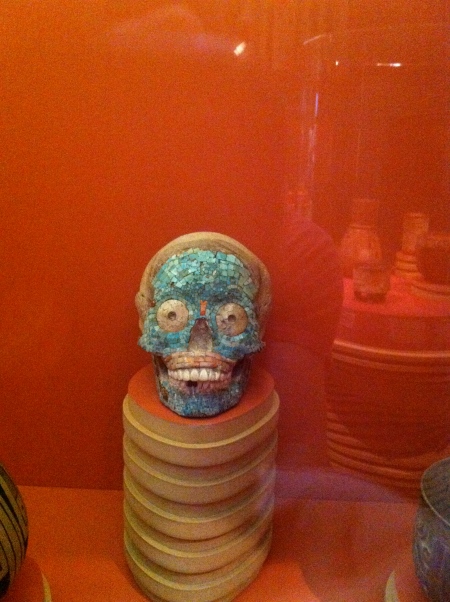This is my second attempt at this post, the first having mysteriously disappeared, spooky.
In my ongoing effort to better appreciate the elusive qualities of Mesoamerican art, the Better Half aand I spent our friday date night exploring the galleries of Ancient American art at LACMA. It really is a wonderful gallery, very broad in its scope, a true treasure trove. But amongst the calligraphic beauty of gracefully decorated Mayan ceramics and the beguiling jadeite baubles, there are many ghoulish artifacts of a culture long lost.
Western Oaxaco or Puebla
1400-1521
human skull with inlaid turquoise, jadeite and shell
Mexico is of course well known for its ornamental use of skulls ; living in LA, particularly this time of year, it is difficult to avoid their toothy grins. But as I explore Mesoamerican art more thoughtfully I am better understanding the cultural significance of these ghoulish delights. What I had initially dismissed as a taste for the macabre now holds greater significance; renewal of life lies at the heart of this obsession with death.
Given the season, I thought a little sampling of our recent visit was in order.
The following shell pendant is quite a delight, very small and of obvious appeal to modern taste.
Mexico, Aztec
1350- 1520
shell
LACMA
This ceramic censor has similar appeal.
Mexico
1400-1521
ceramic
LACMA
I’m afraid the following hasn’t any charm at all, in fact it is quite terrifying.
It is an image fashioned of basalt in which a priest is garbed in the flayed flesh of a sacrificial victim. This costume, part of a spring equinox ritual, in which the priest is dressed as the god Xipe Totec, Our Lord of the Flayed One. The celebrant will wear this horrifying ensemble for 21 days, at which time, the flesh rotting off his body, he will emerge reborn.
Lovely.
But as my professor wisely pointed out, flaying seems to be a universal vice, one need to look no further then Apollo and Marsyas.
With that point made, I quickly fell off my Eurocentric high-horse.
 A play upon Death and the Maiden, the beloved posing for scale and for cuteness.
A play upon Death and the Maiden, the beloved posing for scale and for cuteness.
Male Figure in Guise of Xipe Totec
Mexico, Aztec
1400-1521
basalt
LACMA
A western version of a similar image, equally ghoulish, but from my perspective more poetic.
Apollo and Marsyas
1616-20
oil on canvas
Saint Louis Art Museum
With that, I will close this post, i must rush off to the gym to fend off Death and renew this aging bag of bones.
Have quite a Happy Halloween!
Babylon Baroque




































